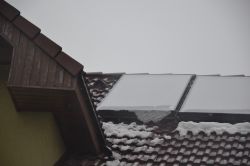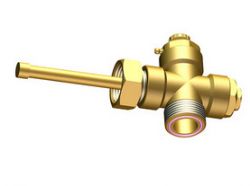Good morning,
let this thread be a CAUTION to others!
We have a solar installation with 2 Viessmann collectors, which is quite unusual because the tank (250 l) is placed in the attic, horizontally. This resulted in the fact that it was not possible to supply the heat exchanger inside the tank with solar fluid. Instead, there are two circuits (one with a pump and solar fluid and the other, flooded with water, behind the external heat exchanger).
About two years ago there was a problem of the pressure drop on the manometer to zero at low temperatures. As soon as the sun came up, the installation came to life (pressure increased, water was heated). Unfortunately, it was ignored by my father, until the pressure indicated on the pressure gauge was still 0 even with quite strong sunlight. pump fluid into the system, which caused the safety valve to operate, and then found that the pressure gauge "blocked something" and therefore indicated 0, although the system was still under pressure. So they changed the pressure gauge, I think they vented the installation and went.
Unfortunately, a few weeks ago, I was in the attic, by the way, and by accident I noticed that something was wrong - the pressure on the pressure gauge was zero again. Moreover, when the air temperature was negative, the sun appeared, the collectors got hot, and the controller switched on the solar fluid circuit. Interestingly, on the pump unit indicators the return temperature (after the solar pump) was higher (!) Than on the supply (about 15 degrees on the supply, and 40 degrees on the return). The pump was hot, the pipes downstream of the pump (towards the collectors) were hot. Heat exchanger completely cold, tank circulation pipes also cold.
What we did - we turned off the entire controller because I was concerned that the pump might be damaged. We found that there was no pressure (only a little fluid spilled out when the valve was opened). I poured it into a cup, put it in the freezer. The effect after an hour is a dark brown slush. So I ordered a new solar fluid and a filling pump.
Unfortunately, after ordering the pump and fluid, it turned out to be the case the frozen liquid burst (!) the vent at the collectors and torn the flexible pipe connecting the two panels . Failure visible through binoculars from ground level. Let this thread become a warning to other users of the installation. After reading my story, everyone can probably conclude that "experts" should immediately notice that the fluid has changed color and recommend its replacement, or check its freezing point with a refractometer. Unfortunately this did not happen - They just stammered that it is dark, but nothing about the possible consequences. And they also charged 250 zlotys for the entire operation. And then my father did not know that this meant that the fluid was only fit for replacement. It turns out that in Poland you should know everything, because it is difficult to find real professionals ...
In addition, we noticed that the panels are not mounted at the same height, through the flexible tube, which should be straight, is strongly bent. When we go out on the roof, I'll put some photos. This is why it was torn out of one collector.
The company is an authorized installer of Viessmann, province. Lower Silesia, town on B., company XX. I am considering sending an official letter to the Polish branch of Viessmann. I do not count on the money, because the installation is 8 years old, but let them at least be aware of the problem and that they have such bugs for an authorized installer.
Regards and I do not wish to contact this company,
MK
let this thread be a CAUTION to others!
We have a solar installation with 2 Viessmann collectors, which is quite unusual because the tank (250 l) is placed in the attic, horizontally. This resulted in the fact that it was not possible to supply the heat exchanger inside the tank with solar fluid. Instead, there are two circuits (one with a pump and solar fluid and the other, flooded with water, behind the external heat exchanger).
About two years ago there was a problem of the pressure drop on the manometer to zero at low temperatures. As soon as the sun came up, the installation came to life (pressure increased, water was heated). Unfortunately, it was ignored by my father, until the pressure indicated on the pressure gauge was still 0 even with quite strong sunlight. pump fluid into the system, which caused the safety valve to operate, and then found that the pressure gauge "blocked something" and therefore indicated 0, although the system was still under pressure. So they changed the pressure gauge, I think they vented the installation and went.
Unfortunately, a few weeks ago, I was in the attic, by the way, and by accident I noticed that something was wrong - the pressure on the pressure gauge was zero again. Moreover, when the air temperature was negative, the sun appeared, the collectors got hot, and the controller switched on the solar fluid circuit. Interestingly, on the pump unit indicators the return temperature (after the solar pump) was higher (!) Than on the supply (about 15 degrees on the supply, and 40 degrees on the return). The pump was hot, the pipes downstream of the pump (towards the collectors) were hot. Heat exchanger completely cold, tank circulation pipes also cold.
What we did - we turned off the entire controller because I was concerned that the pump might be damaged. We found that there was no pressure (only a little fluid spilled out when the valve was opened). I poured it into a cup, put it in the freezer. The effect after an hour is a dark brown slush. So I ordered a new solar fluid and a filling pump.
Unfortunately, after ordering the pump and fluid, it turned out to be the case the frozen liquid burst (!) the vent at the collectors and torn the flexible pipe connecting the two panels . Failure visible through binoculars from ground level. Let this thread become a warning to other users of the installation. After reading my story, everyone can probably conclude that "experts" should immediately notice that the fluid has changed color and recommend its replacement, or check its freezing point with a refractometer. Unfortunately this did not happen - They just stammered that it is dark, but nothing about the possible consequences. And they also charged 250 zlotys for the entire operation. And then my father did not know that this meant that the fluid was only fit for replacement. It turns out that in Poland you should know everything, because it is difficult to find real professionals ...
In addition, we noticed that the panels are not mounted at the same height, through the flexible tube, which should be straight, is strongly bent. When we go out on the roof, I'll put some photos. This is why it was torn out of one collector.
The company is an authorized installer of Viessmann, province. Lower Silesia, town on B., company XX. I am considering sending an official letter to the Polish branch of Viessmann. I do not count on the money, because the installation is 8 years old, but let them at least be aware of the problem and that they have such bugs for an authorized installer.
Regards and I do not wish to contact this company,
MK




